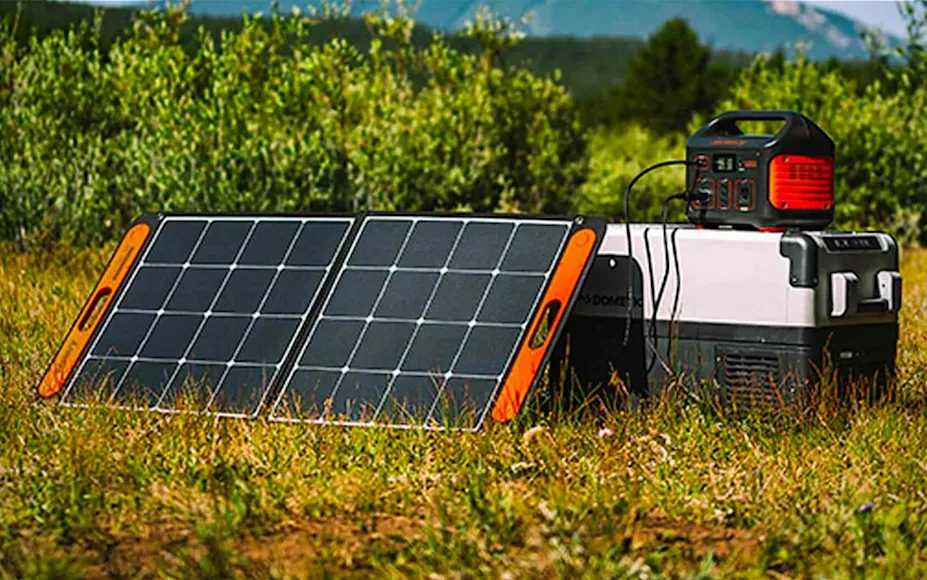_We may earn revenue from the products available on this page and participate in affiliate programs. Learn more ›
_
Best Overall
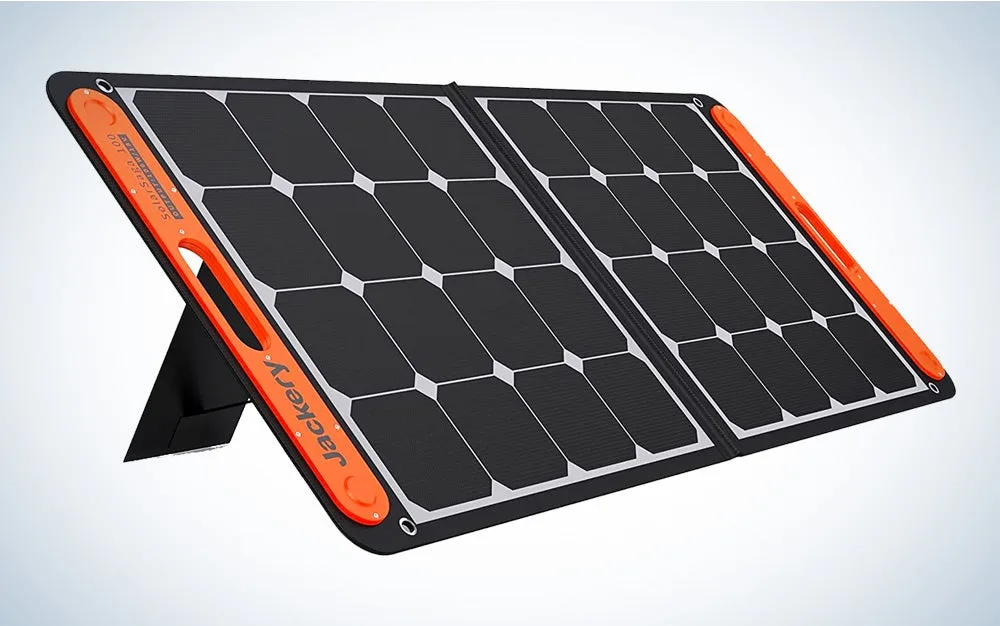
Jackery SolarSage 80-Watt
Best Foldable
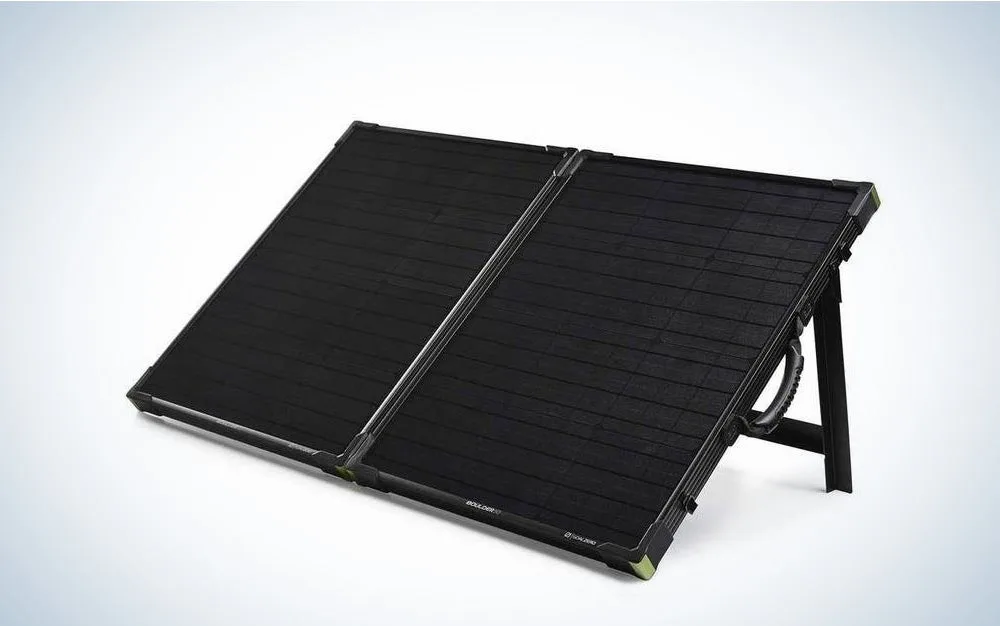
Goal Zero Boulder 100 Briefcase
Best for RV
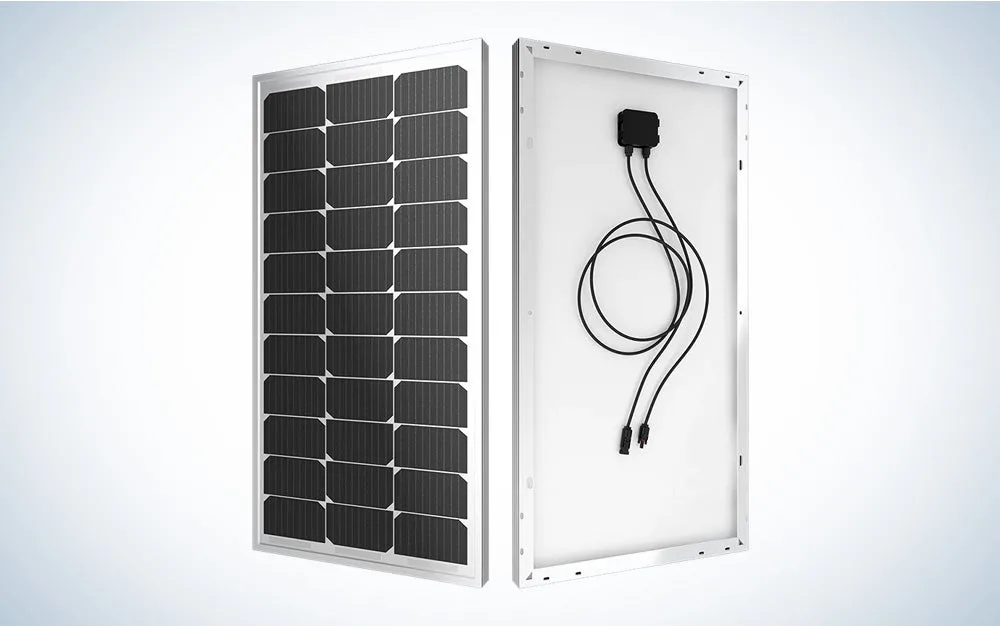
Bouge RV 12V 9BB
Solar panels allow for a reusable supply of electrical energy even when you’re deep in the backcountry. While we know some campers want to get away from it all and rough it, it’s hard to completely disconnect from electrical devices these days. Power is even more important for backcountry campers and thru-hikers who want to stay connected to friends and family through their cell phones and spot devices. Fortunately, the sun provides us with a never-ending supply of renewable energy. Solar panels can use this convertible energy to help power a variety of devices. They come in different sizes, wattages, and designs to fit just about every style of camping there is. Here are our top picks for the best solar panels for camping.
Best Overall: Jackery SolarSaga
Best Portable: Big Blue 3 Solar Charger
Best Foldable: Goal Zero Boulder 100 Briefcase
Best for RV: Bouge RV 12V 9BB
Best Lightweight: Goal Zero Nomad 5
Best Budget: Tranmix Solar Charger
How We Made Our Picks
I started using solar power for my camping adventures during the last few years. This led to the development of a complete solar system for my camper van conversion. I’ve spent an inordinate amount of time figuring out what adapters I need to convert the power from an MC4 to an 8mm. While figuring out the best solar panels for this list, we also considered many other important factors for each one:
Wattage: What’s the maximum amount of power the panel can draw from the sun?
Connectors: What type of connectors did the manufacturer use? How easy are they to connect to a battery or solar generator?
Dimensions and Weight: Is this panel intended to be mounted on an RV roof? Or is it built to stow into a backpack for charging cell phones?
Durability: Is this a panel meant to be outside 24/7? What type of metal is the frame made from?
Value: Does the capability and construction of the panel match the price tag?
Best Solar Panels for Camping: Reviews & Recommendations
Best Overall: Jackery Solar Saga
Best Overall

Specs
Rated Power: 100 Watts
Connectors: 8mm, USB
Dimensions: 22.83” x 19.69” x 2.36”
Weight: 10.33 Pounds
Pros
Durable and waterproof
Extension cable included
Extra ports for charging a phone
Cons
Expensive
Jackery has a reputation for quality gear, and their two SolarSaga panels—100-watt and 80-watt—are considered some of the best in the business. The 100-watt version has all the standard features one expects in a panel. There is a kickstand for getting the right angle, high-quality monocrystalline silicon solar cells, and a laminated case to protect it. Additionally, Jackery gave this panel two USB ports to charge a small device like a cellphone.
While Jackery designs its products to interact with its portable power stations, these panels can easily be used for other solar setups too. Other bonus features worth mentioning include the pockets to hold extra power cords, adapters, and other small accessories. Another feature that sets this solar panel apart from many others is the 10-pound weight, which is half of many comparatively sized offerings. Other than the $250 price tag, this is a solid solar panel built for a variety of camping scenarios.
Best Portable: Big Blue 3 Solar Charger
Best Portable
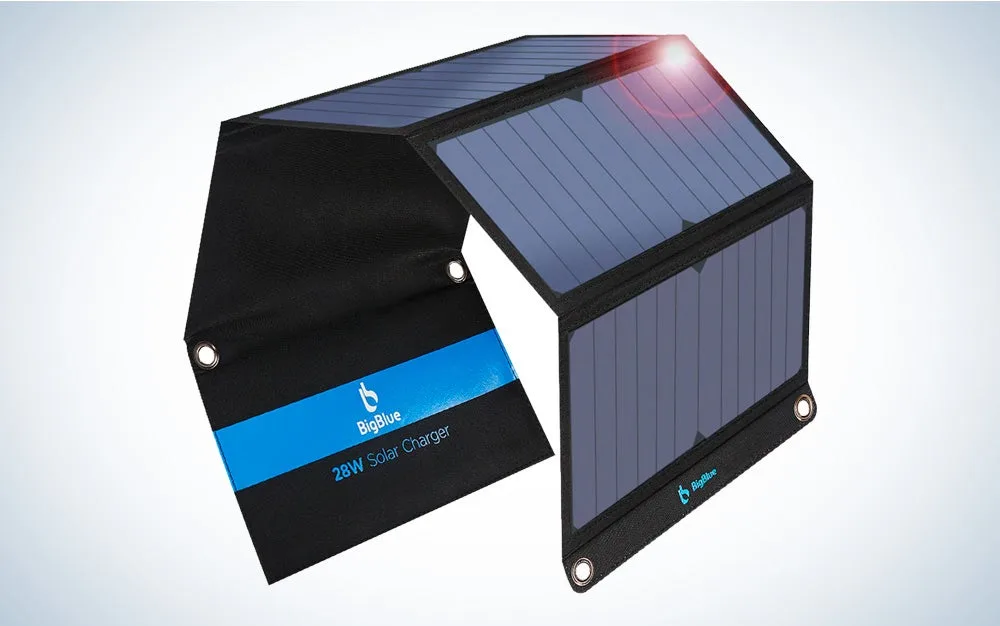
Specs
Rated Power: 28 watts
Connectors: USB
Dimensions: 11” x 6.3” x 1.3”
Weight: 20.6 ounces
Pros
Can charge multiple devices at once
Great price point
Folding design keeps it compact
Cons
Power bank not included
When it comes to multi-functional lightweight panels that can charge multiple devices at the same time, the Big Blue is one of the highest-rated on the market. This foldable solar panel is under two pounds and can pump out 28 watts of power. The dimensions are small enough to easily fit into a pack for multi-day backpacking adventures. The Big Blue 3 also has a polymer surface to help protect it in damp conditions.
While many reviews rave about the versatility of this panel in the backcountry, a review by “Techguy”
on Amazon notes how dozens of these panels were used by families to power up phones, walkie-talkies, fans, flashlights, and more in the wake of Hurricane Maria in Puerto Rico. Anything that’s disaster-ready will also suit a short backpacking trip into the wilderness just fine. The only downside is that a good power bank
is not included.
Best Foldable: Goal Zero Boulder 100 Briefcase
Best Foldable

Specs
Rated Power: 100 Watts
Connectors: 8mm
Dimensions (unfolded): 26” x 43” x 1.75”
Weight: 25.9 Pounds
Pros
Extremely durable construction
Great carry handles
Pairs perfectly with a power station
Cons
Expensive
Heavy
I’ve owned the Goal Zero for a little over a year now, and it continues to impress me on every trip. I use the 100-watt version, but Goal Zero also builds a 200-watt version for anyone who needs more power. Goal Zero used some beefy aluminum in the construction of this panel. Add in tempered glass, and you’ve got a tough piece of equipment. Case in point, I’ve dropped this panel on concrete and slammed it into doors without it getting a single scratch.

The Boulder 100 features excellent handles for easy transport. Note the Yeti500x power station. Travis Smola
I mostly use this panel in conjunction with a Goal Zero Yeti500x power station, but I’ve found it works with my Bouge RV power station, too, given the right adapter. Last year I used this panel to run a large Dometic cooler, a 17-inch laptop, and my WiFi hotspot while working from the back of a Jeep.

The adjustable legs of the Boulder are as rugged as the panel itself. Travis Smola
I found this panel tends to peak around 55 to 70 watts of input when the sun is in perfect position, which is more than enough for my needs. The only downside is that it weighs about 25 pounds. At that weight, it’s too much for backpackers. Additionally, the panel is expensive. However, these panels go on sale all the time, and it’s worth waiting for a drop.
Best for RV: Bouge RV 12V 9BB Solar Panel
Best for RV

Specs
Rated Power: 100, 180, and 200-Watt models
Connectors: IP67 Waterproof MC4
Dimensions (100 Watt): 39” x 21” x 1.38”
Weight: 16.97 Pounds
Pros
Affordable
Lightweight aluminum frame
Extremely efficient
Cons
Bouge doesn’t package well from the factory
The Bouge RV was an easy pick for trailers and motorhomes due to its light weight and durability. I mounted this panel on the roof of a 2022 Ram Promaster City van. Thus far, I’ve been pleased with the performance. During testing, the 100-watt version pulled a peak wattage of 65 to 75 watts rather consistently with the sun in perfect position on a cloudless day. This might be the best-performing and least expensive panel I tested.
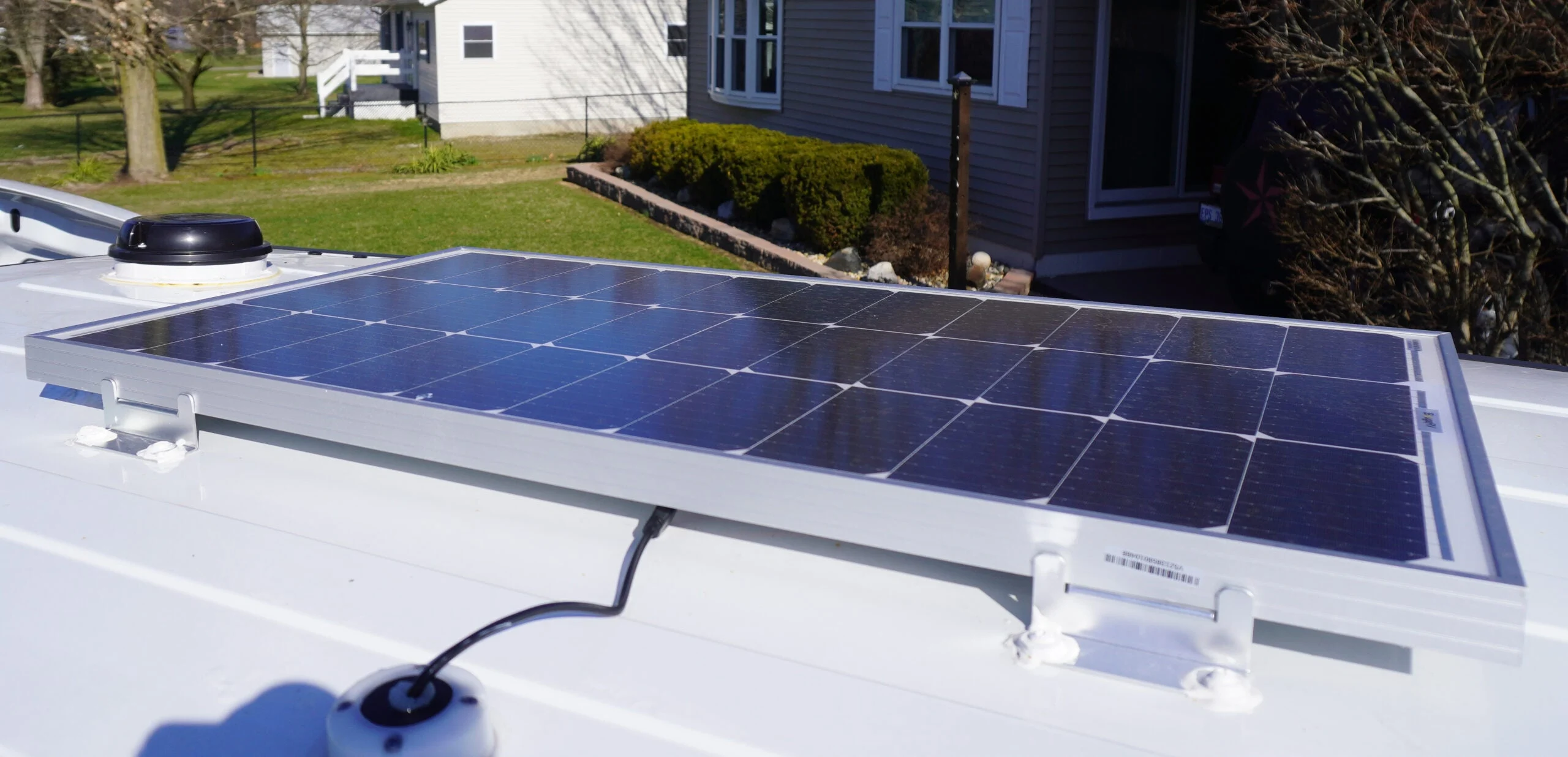
The Bouge RV 9BB mounted on the roof of the author’s van using Bouge’s mounting brackets. Travis Smola
We used Bouge RV’s brackets to permanently mount the panel to the van and it has held up well thus far. These panels have MC4 IP67 waterproof connectors, which tuck nicely under the panel. Because they used an aluminum frame, I haven’t been afraid to leave the van and panel parked in the rain.
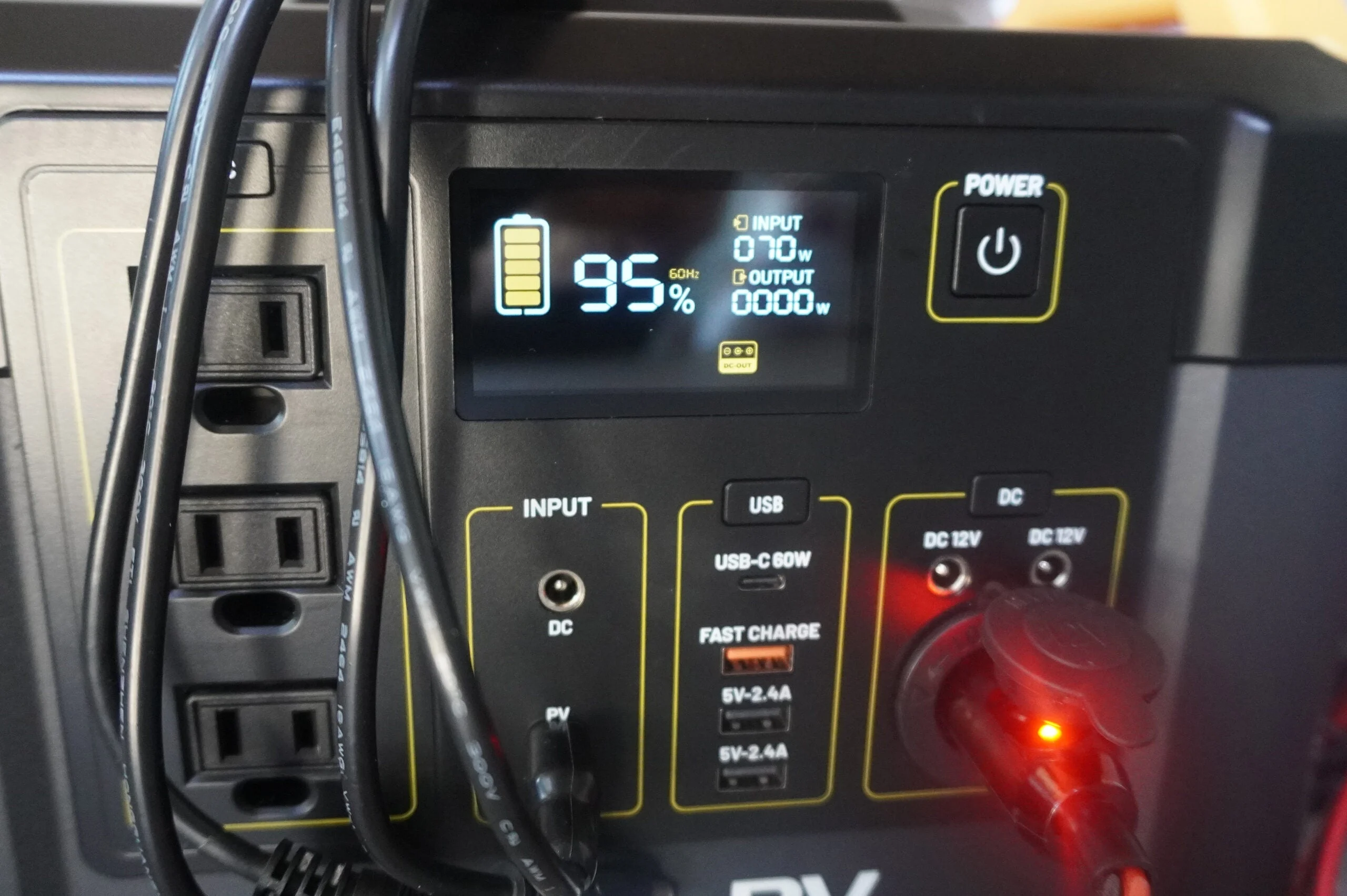
The display on the author’s Bouge RV power station showing 70 watts of input from the 9BB solar panel. Travis Smola
The biggest issue with these panels has nothing to do with the construction. Bouge RV uses minimal packaging with no padding when shipping these panels. Multiple Amazon reviews mention that their panels arrived with dents and dings
. For the record, I had no issues ordering two of these panels, but it is worth inspecting. For the price point, these panels are a great bargain.
Best Lightweight: Goal Zero Nomad 5
Best Lightweight
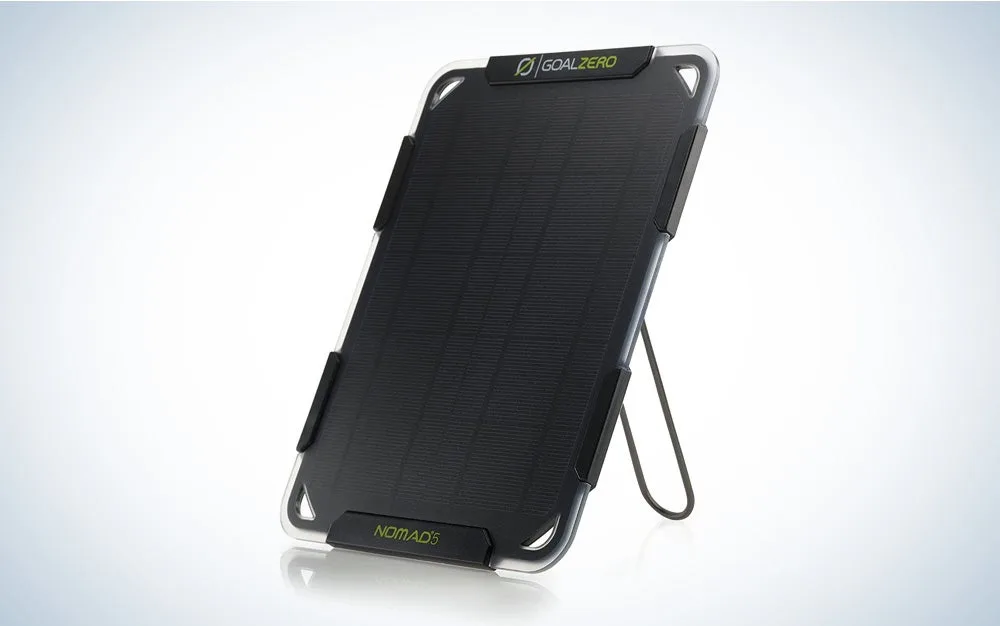
Specs
Rated Power: 5 watts/volts
Connectors: USB outlet
Dimensions: 9.5” x 7 x 0.8”
Weight: 12.7 ounces
Pros
Extremely light
Ruggedly built
Affordable
Cons
No battery bank
The Goal Zero Nomad 5 weighs well under a pound and is an easy choice for the best lightweight panel. Once again, Goal Zero’s rugged materials and construction come out on top here with this simple 5-watt monocrystalline panel. This unit is best for charging a cell phone or camera while deep in the backcountry. I like how thin this panel is too; it slips perfectly into a smaller pocket on a backpack for easy carrying. The back of the panel has a simple kickstand that allows campers to adjust the panel to an optimal angle. One downside is that Goal Zero does not include a power bank with this panel if you want to stow some energy away for charging at night. At five watts, it is also slightly underpowered for anything other than a cell phone.
Best Budget: Tranmix Solar Charger
Best Budget

Specs
Rated Power: 6 watts
Connectors: USB
Dimensions: 6.1” x 3.3” x 1.37”
Weight: 1.18 pounds
Pros
Huge power bank
Highly affordable
Bonus flashlight adds functionality
Cons
Some durability concerns
At under $50, the Tranmix is a great, inexpensive deal for a 25000 mAh portable power bank that is outfitted with four small solar panels to keep you off-grid for long periods. The massive capacity of this bank allows you to charge your phone multiple times without recharging the bank itself. Because the whole unit is extremely light, this is a nice option for thru-hikers who want to keep their devices charged.
The downside to the Tranmix is the fact that durability issues seem to be a common issue. We noted several Amazon reviews
where users reported the case cracked
. However, considering the awesome energy storage capacity and the price, this panel is a great budget option.
FAQs
Q: What is the best wattage for solar panels for camping?
This depends on a camper’s needs. For hikers who just need to power up a cellphone, a simple 5 or 10-watt panel will likely do the trick. If you need enough power for a small fridge or electric cooler, a panel of at least 100 watts is needed. Most RVs are fitted with panels of at least 180 watts from the factory these days to run things like lights, a pump, and a fridge when not plugged into shore power. Generally, the more batteries you use, the larger the panels you will need.
Q: What are the benefits of solar panels for camping?
Besides the obvious environmental benefits of using the sun’s rays as a renewable energy resource, campers can benefit greatly from solar panels in other ways. The biggest is being able to stay in dispersed camping areas with a lack of hookups while still being able to utilize all your electronics. With the nightly rates for campsites rising yearly, freedom from modern campgrounds can save hundreds or even thousands of dollars per year, depending on how much you camp.
Q: Can a solar panel overcharge a battery?
It is possible to damage a battery by overcharging it with a solar panel. However, this is becoming less of a concern these days. Many panels and portable generators feature built-in over-power and surge protections that will stop charging once the battery hits full capacity. We also recommend simply never leaving a panel completely unsupervised to ensure such accidents never happen in the first place.
What to Consider When Choosing a Solar Panel
Most companies put the maximum wattage on their solar panels, but in my experience, it is rare to get that maximum input from most panels. With the 100-watt panels I use, I’ve found the max wattages tend to be around 50 to 80 watts of output on a clear day. Cloud cover also plays a huge factor in the efficiency of a solar panel. Some panels are better than others when the sun is hidden. But never expect great charging when the sun is rising or setting.
Besides cloud cover, the angle of the panel and its position relative to the sun matter too. With a portable folding panel, it’s easy to keep turning it to follow the sun throughout the day. Meanwhile, a panel that’s fixed to a roof can only reach peak capacity for a limited amount of time each day.
Additional Considerations
You also want to consider if your panel outputs enough energy for the battery or power station you are using. For example, I have a Bluetti 2,000-watt hour power station
that cannot be charged by any 100-watt panels. This is because the panels only output 12 volts, and the station requires a solar input of at least 35 volts. This means I need to buy another, higher-wattage panel to charge that station in the field.
Another factor to consider is the length of the cable between your battery/solar generator and the panel itself. Most manufacturers offer only a short cord with their panels, undoubtedly so they can make a little extra money from selling extensions. Whatever the reason may be, the fact of the matter is that the longer the extension cord, the more energy you’ll lose in the transfer. Thus, if you are planning a van build, it pays to plan ahead and keep your cord between the battery and panel as short as possible.
Best Solar Panels for Camping: Final Thoughts
Best Overall: Jackery SolarSaga
Best Portable: Big Blue 3 Solar Charger
Best Foldable: Goal Zero Boulder 100 Briefcase
Best for RV: Bouge RV 12V 9BB
Best Lightweight: Goal Zero Nomad 5
Best Budget: Tranmix Solar Charger
The combination of the Jackery’s durability, and bonus features makes it an easy pick for our best overall camping solar panel. Additionally, the functionality with the entire Jackery line helps add value. When it comes to panels built to withstand the rigors of the outdoors, it’s a hard one to beat.
Why Trust Us
For more than 125 years, Field & Stream has been providing readers with honest and authentic coverage of outdoor gear. Our writers and editors eat, sleep, and breathe the outdoors, and that passion comes through in our product reviews. You can count on F&S to keep you up to date on the best new gear. And when we write about a product—whether it’s a bass lure or a backpack—we cover the good and the bad, so you know exactly what to expect before you decide to make a purchase.

